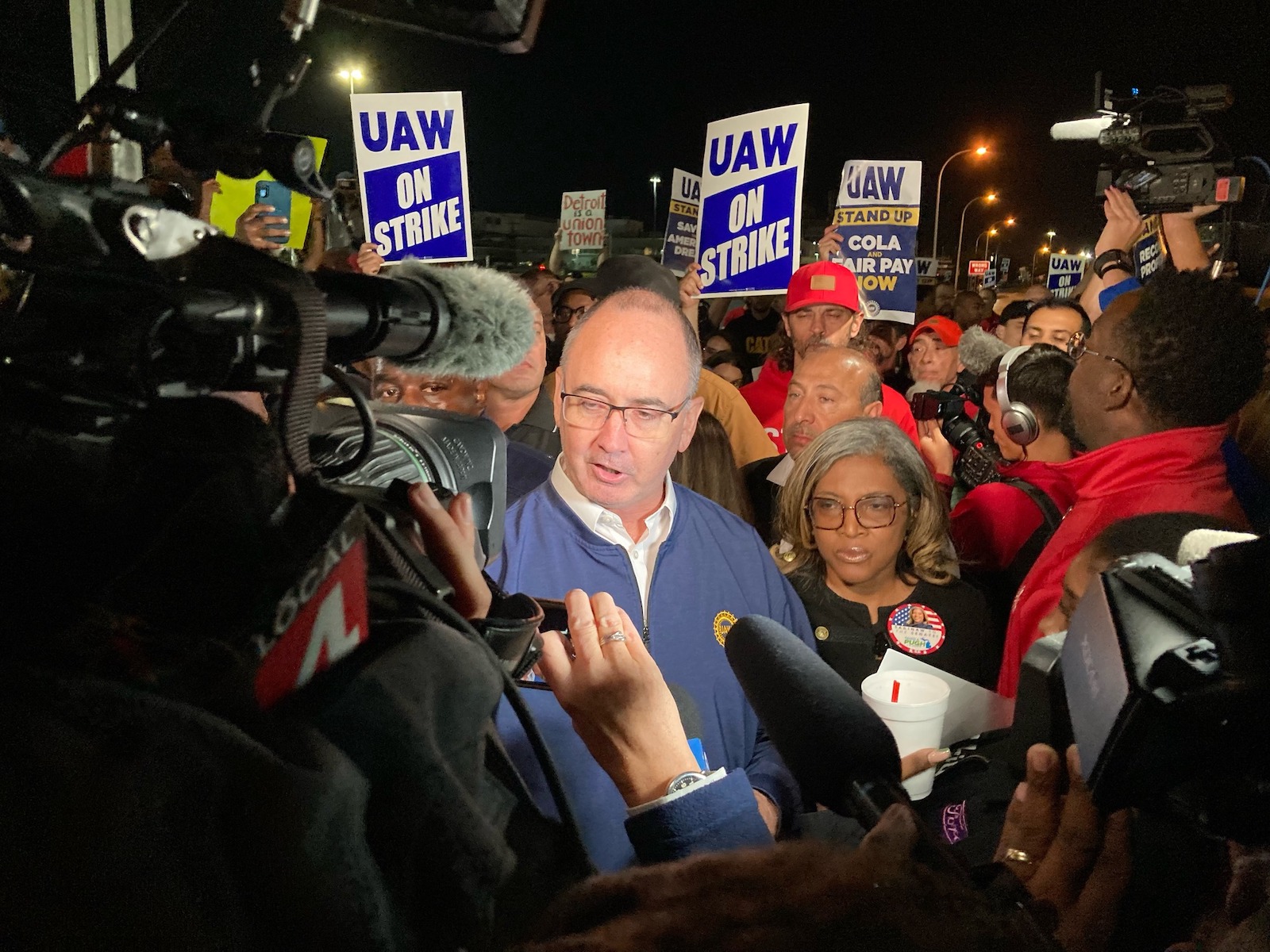Though Detroit Big Three automakers have reportedly upped their offers to the United Auto Workers union launched a historic strike last Thursday night, there are few signs that the union is ready to settle.
The immediate question hanging over the negotiations is whether UAW President Shawn Fain will follow up on his threat to expand the current walked which has, so far, been limited to one plant for each of Detroit’s Big Three automakers. Even if he maintains the current status the impact of the confrontation is beginning to grow, with several automakers and suppliers threatening layoffs.
There had been some expectations the Biden administration might take steps to bring resolution to the stalled contract talks. The White House earlier assigned a senior adviser to the president as an observer. But Fain dashed such hopes during a Monday morning appearance on MSNBC. Asked if the president could help broker agreement, Fain responded, “Not at all.”

The UAW strike is now four days old, and while progress is reportedly being made, the end isn’t near.
A new strategy
Ahead of the 11:59 p.m. strike deadline last Thursday, Fain announced during a Facebook Live appearance that workers would walk out at a General Motors plant in Wentzville, Missouri, a Ford line outside Detroit, and the Stellantis Jeep complex in Toledo, Ohio. It marked the first time in UAW history that it struck all three automakers simultaneously. Traditionally, the union focuses on a “strike target” seen likely to yield the most lucrative agreement before moving on to the other companies.
But those three plants produce high-demand, high-profit models, such as the Jeep Wrangler and Ford Bronco. Collectively, they’re believed to be losing production of an estimated 3,200 vehicles per day, according to S&P Global Mobility, which translates that into about $150 million in lost sales per day.
The three automakers reportedly stepped up production in the weeks leading up to the strike. But the industry is still struggling to rebuild dealer inventories, especially of its most popular models, following the disruptive impact of COVID shutdowns and the lengthy semiconductor shortage.

UAW President Shawn Fain says the Biden administration won’t be able to help resolve the issues between the union and automakers.
The strike is expected to have a growing impact beyond the confines of the Big Three the longer it drags on. The trade group, the Alliance for Automotive Innovation, calculates there are 11.5 “indirect” jobs for every UAW worker. So, if the UAW were to eventually pull all 150,000 members out at the Big Three the total impact would be nearly 1.9 million. And that doesn’t include the impact a strike normally has on the businesses, such as restaurants, shops and hair salons, that service autoworkers.
Impact on the economy
That prospect has raised deep concerns at the White House, according to numerous reports, the president concerned that a lengthy walkout could trigger a long-feared recession — just as Biden pushes forward with his campaign for a second term.
Longtime advisor Gene Sperling was assigned to closely monitor the auto talks, and Labor Secretary Julie Su has also been keeping close tabs, according to the White House.
But Fain dismissed any role for the administration.
“The battle is not about the president,” he said during an appearance on MSNBC’s “Morning Joe.”
“It’s not about the former president or any other person prior to that. This battle is about the workers standing up for economic and social justice and getting their fair share because they’re fed up with going backwards,” he added.
U.S. Treasury Secretary Janet Yellen told CNN, “the two sides need to narrow their disagreements and work for a contract. That’s good for the workers and for the industry as well.” She also said the White House’s goal is to have a “win-win” agreement for the parties.
On Monday, supplier CIE Newcor notified Michigan regulators that it is preparing to lay off 293 workers effectively idled by the strike. Ford told 600 workers not to report in. GM warned 2,000 hourly employees that they could be out of work this week because their plant can’t get parts normally produced at the struck Wentzville assembly plant.
And unlike what would happen in other situations, those GM and Ford workers won’t get company provide “SUB” pay because their own jobs were impacted by a strike.
UAW covering strikers
The UAW is covering idled members from the strike fund it set up. It started out with an $825 million balance. But, with each worker on the picket line collecting $500 a week, it could be drawn down quickly — especially if more plants are targeted.
Both sides continue to talk, with each of the three Detroit automakers offering up revisions to their earlier proposals. (There is no collective agreement covering all of the manufacturers, though they’re eventually expected to adopt similar settlements.
Trade publication Automotive News last week reported the union backed down from its original wage demand calling for a 46% hike over the course of the four-year agreement. But sources indicate the automakers are still holding firm at something in the high 20% range.
Other issues to be resolved include pensions, the end of tiered contract, profit sharing and other monetary issues. And the union has raised the prospect of a 32-hour work week, though the broad consensus among industry watchers is the final settlement will likely come in with significant increases in time off but retain a 40-hour clock.





0 Comments